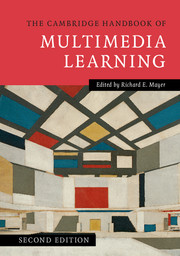Book contents
- The Cambridge Handbook of Multimedia Learning
- The Cambridge Handbook of Multimedia Learning
- Copyright page
- Contents
- Contributors
- Preface
- Acknowledgments
- 1 Introduction to Multimedia Learning
- Part I Theoretical Foundations
- Part II Basic Principles of Multimedia Learning
- 6 Ten Common but Questionable Principles of Multimedia Learning
- 7 The Multimedia Principle
- 8 The Split-Attention Principle in Multimedia Learning
- 9 The Modality Principle in Multimedia Learning
- 10 The Redundancy Principle in Multimedia Learning
- 11 The Signaling (or Cueing) Principle in Multimedia Learning
- 12 Principles for Reducing Extraneous Processing in Multimedia Learning: Coherence, Signaling, Redundancy, Spatial Contiguity, and Temporal Contiguity Principles
- 13 Principles for Managing Essential Processing in Multimedia Learning: Segmenting, Pre-training, and Modality Principles
- 14 Principles Based on Social Cues in Multimedia Learning: Personalization, Voice, Image, and Embodiment Principles
- Part III Advanced Principles of Multimedia Learning
- Part IV Multimedia Learning of Cognitive Processes
- Part V Multimedia Learning in Advanced Computer-Based Contexts
- Author Index
- Subject Index
13 - Principles for Managing Essential Processing in Multimedia Learning: Segmenting, Pre-training, and Modality Principles
from Part II - Basic Principles of Multimedia Learning
Published online by Cambridge University Press: 05 August 2014
- The Cambridge Handbook of Multimedia Learning
- The Cambridge Handbook of Multimedia Learning
- Copyright page
- Contents
- Contributors
- Preface
- Acknowledgments
- 1 Introduction to Multimedia Learning
- Part I Theoretical Foundations
- Part II Basic Principles of Multimedia Learning
- 6 Ten Common but Questionable Principles of Multimedia Learning
- 7 The Multimedia Principle
- 8 The Split-Attention Principle in Multimedia Learning
- 9 The Modality Principle in Multimedia Learning
- 10 The Redundancy Principle in Multimedia Learning
- 11 The Signaling (or Cueing) Principle in Multimedia Learning
- 12 Principles for Reducing Extraneous Processing in Multimedia Learning: Coherence, Signaling, Redundancy, Spatial Contiguity, and Temporal Contiguity Principles
- 13 Principles for Managing Essential Processing in Multimedia Learning: Segmenting, Pre-training, and Modality Principles
- 14 Principles Based on Social Cues in Multimedia Learning: Personalization, Voice, Image, and Embodiment Principles
- Part III Advanced Principles of Multimedia Learning
- Part IV Multimedia Learning of Cognitive Processes
- Part V Multimedia Learning in Advanced Computer-Based Contexts
- Author Index
- Subject Index
Summary
When a concise multimedia lesson containing complicated material is presented at a fast rate, the result can be a form of cognitive overload called essential overload. Essential overload occurs when the amount of essential cognitive processing (similar to intrinsic cognitive load) required to understand the multimedia instructional message exceeds the learner’s cognitive capacity. Three multimedia design methods intended to minimize essential overload are the segmenting, pre-training, and modality principles. The segmenting principle is that people learn more deeply when a multimedia message is presented in learner-paced segments rather than as a continuous unit. This principle was supported in 10 out of 10 experimental tests, yielding a median effect size of 0.79. The pre-training principle is that people learn more deeply from a multimedia message when they know the names and characteristics of the main concepts. This principle was supported in 13 out of 16 experimental tests, yielding a median effect size of 0.75. The modality principle is that people learn more deeply from a multimedia message when the words are spoken rather than printed. This principle was supported in 53 out of 61 experimental tests, yielding a median effect size of 0.76.
Keywords
- Type
- Chapter
- Information
- The Cambridge Handbook of Multimedia Learning , pp. 316 - 344Publisher: Cambridge University PressPrint publication year: 2014
- 91
- Cited by



